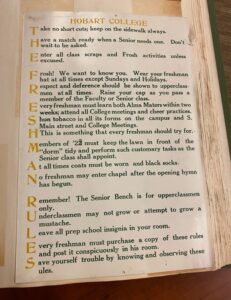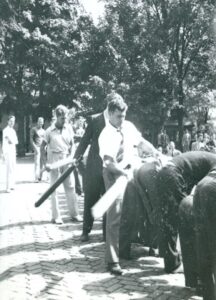The Rite of Passage for Hobart Freshmen in the 20th Century
By Nicole Wadsworth, Intern
Rites of passage are a prominent part of the human experience. By utilizing a variety of ritualistic practices and ceremonies, the primary purpose is to shift a person from one social status to another. To do so, rites of passage are specifically split into three stages: separation, in which a person is both physically and symbolically separated from their previous or familiar identities; transition or liminality, the stage in-between the two identities; and return or re-integration, in which the ritual is complete, a new identity is assumed, and the person can re-enter society with that newly gained status. During the rite of passage process, the initiates are usually placed in a subordinate position by the “masters,” or those who have already been initiated. They typically have to endure and pass various trials (which usually consist of humiliation, isolation, or fasting) before they can acquire their new social status and are allowed to re-enter the community.
Today, rites of passage manifest in ceremonies or experiences like school graduation ceremonies, weddings, and baptisms, among others. But throughout the 20th century, freshmen at Hobart College had encounters with rites of passage, as their first year experiences were akin to undergoing various rite practices. The social rules they followed, established and enforced by the senior class, exemplify this. These rules, usually published in small guidebooks called “H Books” or displayed on posters, dictated how a freshman should act or look around campus and intended to emphasize their statuses as Hobart freshmen. They were meant to further enforce a certain social hierarchy and power dynamic in which the seniors were on top, as per their “time-honored right.” Further, it was thought to be honorable for seniors to carry out this enforcement because it was considered, as per a 1906 Hobart Herald article, “a necessity for the proper handling and governing of the student body.” Though there was some variation over the years, the most recurring rules were:
- Freshmen were expected to only walk on sidewalks; cutting through campus grounds was not allowed.
- Freshmen must always wear their designated freshmen caps with the exception of Sundays and holidays. They must also always wear certain ties and socks (usually black), and had to wear coats (whenever they were in public and as an alternative to sweaters, which also weren’t allowed).
- Respect must always be shown to the senior class and faculty. This manifested in a variety of ways, such as removing or tipping hats in their presence, saluting, knowing every senior by name, and generally following what they say.
- Freshmen were not allowed to smoke on campus grounds or on South Main Street, but they had to carry matches with them at all times in case a senior wanted to light his cigarette.
- Freshmen must be in their seats in the designated freshmen section at the chapel before the first hymn.
- Class precedence must always be shown.
- Freshmen must learn and know the Hobart Alma Mater and the other college cheers, and they were usually expected to have these songs memorized within a certain time frame. Further, they were generally expected to stay true to the Alma Mater and the traditions it honored.
- Freshmen were expected to attend every college event, meeting, and athletic competition.
- At athletic competitions, freshmen were not allowed to be seen in the company of a member of the opposite sex.
- High school or prep school insignia were never to be worn; if a freshmen had brought an item displaying that insignia, it would have needed to be hidden in his dorm room .
- Freshmen were not allowed to sit on the Memorial Bench, also known as the senior bench.
- Facial hair was not allowed; freshmen had to be clean shaven at all times.
- Freshmen needed to always carry a copy of these rules or know them by heart. It is also usually noted that, should a freshman fail to follow these rules, seniors or other disciplinarians had the authority to decide how to deal with the transgression.
These rules offer us a glimpse into the rite of passage that Hobart freshmen experienced. While it is archivally difficult to completely encompass these experiences, the rules hint towards what each stage of the rite of passage entailed and how the freshmen were tested.
Separation
An integral part of going to college for many people entails leaving home for the first time and living somewhere else with new people. During this time, it is assumed that the student is beginning to move away from their previous and familiar identity or status to pursue a new one within their new setting. The Hobart freshmen of the 20th century presumably experienced the same thing, in which they are physically separated from their previous status. The separation from their previous status is also further symbolically emphasized by the rule stating that they are not allowed to wear anything with insignia representing their high school or prep school.
The disallowance for facial hair also played a part in separating freshmen from their past selves. If a freshmen entered school with a beard and was informed that he wasn’t allowed to have it, shaving it off symbolically separates himself from his former status, akin to military initiates shaving their heads. These new statuses as Hobart College freshmen are emphasized by their “uniforms” consisting of caps, ties, socks, and coats, all of which made them easily identifiable. Their smoothly-shaven faces also emphasized their younger age and thus their “newbie” identity. In all, these aspects all function to emphasize their newly established subordinate statuses and to separate them from former statuses.
Transition or Liminality
Not only were the Hobart freshmen separated from their past identity, but their statuses were continuously emphasized as distinctly separate from the rest of the student body. Their required “uniforms,” as previously mentioned, made them easily recognizable as freshmen. Additionally, there were often designated sections where they were required to sit during athletic competitions and chapel services. Being unable to embody their previous statuses but also not being allowed to fully integrate into the Hobart student body, Hobart freshmen were in a state of liminality in which they were neither one status nor the other.
Return or Re-integration
The end of a Hobart freshmen’s first year marks the end of the rite of passage. By successfully completing the year and “surviving” the rules and trials, the freshmen are officially initiated. New statuses are assumed and they can now become fully integrated with the rest of the Hobart student body. Once they become seniors themselves, they will also carry on the tradition of enforcing these freshmen rules.
Trials
The trials that Hobart freshmen had to endure were more focused on humiliation than anything else. Their knowledge of and adherence to the rules were tested, and failure resulted in punishment. An email from Grady Jensen, class of 1944 and alumnus of the Kappa Sigma fraternity, describes just how the freshmen were tested:
“All students had to attend noon chapel 3 times per week. The service lasted about 20 minutes. When we (the freshmen) exited the chapel, the seniors were waiting for us. Those of us who couldn’t answer H Book questions or didn’t have our beanies on or matches or H Books with us were in trouble. We were lined up along the walk leading from the chapel door to the entrance of the old, Demarest Library. You’ll note that this walk is along a bank. The ‘guilty’ frosh, lined up along the path overlooking the bank, were then paddled by the seniors, who tried to knock us off the path down the bank.”
Indeed, failure to comply with the rules resulted in a physical and public punishment and humiliation. It ensured compliance and enforced the creation of a “true Hobart man,” while also emphasizing the imbalanced power dynamics between the two classes.
The rite of passage that the Hobart freshmen of the early to mid-20th century had to complete consisted of trivial rules as well as physical and humiliating punishments. Despite the embarrassment, it persisted as a Hobart tradition for years, with the freshmen later becoming the initiated seniors that would continue to enforce these rules. The “true” Hobart man would carry himself with respect and honor and, perhaps most importantly, generated an abundance of Hobart pride.
Nicole Wadsworth is an archivist intern at Historic Geneva for summer 2022. She is a senior at Hobart and William Smith Colleges and is double majoring in Anthropology and Asian Studies.
For more about Hobart College, see our latest exhibit at the Geneva History Museum, Hip Hobart Forever: 200 Years of Hobart College.
Works Referenced
Forth, Gregory, and H. Callan. “Rites of Passage.” The International Encyclopedia of Anthropology, September 5, 2018, 1–7.
H Books from the Hobart and William Smith Archives
Tzanelli, Rodanthi. “Rite of Passage.” Edited by G. Ritzer. The Blackwell Encyclopedia of Sociology, November 7, 2014.
Wilson, F.E., ed. “Class of 1910.” Hobart Herald. October 1, 1906.




Thank you Nicole. Very interesting reading about the early 20th century Freshmen treatment (rite of passage) by seniors.
I believe this was followed by the Fraternities initiation of the freshmen. Today it has sadly developed to more of a ritual of bad drinking behaviour and led to closures of Fraternities.